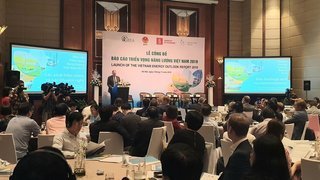According to the 2019 Vietnam Energy Outlook Report, the cost-effective capacity threshold will increase to more than 100GW by 2050, due to anticipated cost reduction in wind and solar technologies.
Jakob Stenby Lundsager, long-term advisor for the Danish Energy Partnership Programme in Vietnam, shared his recommendations for the country towards further sustainable development.
To ensure a stable energy supply amid the increasing demand for power and rising shares of solar and wind in Vietnam’s energy market, what do you recommend for the future?
 |
|
Jakob Stenby Lundsager, long-term advisor for the Danish Energy Partnership Programme in Vietnam
|
For decades, Vietnam has been one of the fastest-growing economies in Asia with a GDP growth rate above 6 per cent per annum. The energy sector plays a significant role in the continued development of the country, and access to affordable and reliable energy will be critical for sustained economic growth. Achieving the necessary global reduction of greenhouse gas emissions, as established under the Paris Agreement, depends heavily on the development path of emerging economies like Vietnam.
The country has favourable conditions to embark on a sustainable development pathway, considering the large domestic resource potential for both solar and wind power. The declining cost of these technologies as well as in battery storage gives Vietnam an advantageous option for a green energy transition. However, such a pathway also entails certain challenges in expanding and integrating renewable energy in the energy system and realising the efficiency potential in the most affordable way across sectors.
These challenges must be addressed by policymakers. Based on well-documented and detailed modelling of the energy system, the Vietnam Energy Outlook Report 2019 provides a scenario-based foundation for policy action by shedding light on the development of the energy system towards 2050. The report is developed by the Electricity and Renewable Energy Authority under Vietnam’s Ministry of Industry and Trade in close collaboration with the Danish Energy Agency; supported by the Danish Embassy in Hanoi and the Institute for Energy Economics and Financial Analysis.
What are some highlights to emerge from the report?
It presents five scenarios, exploring different least-cost development pathways for the Vietnamese energy system. The scenarios serve as indicative what-if scenarios from which insights have been drawn on the relevant themes in the Vietnamese context.
Thereby, the report intends to guide policymakers and inspire deliberation on green transition, while delivering concrete input to the forthcoming National Power Development Plan 8 and the Energy Master Plan. The report is also a central milestone in the Danish Energy Partnership Programme’s long-term scenario, modelling activities and supporting development of Vietnam’s energy system more sustainably through the implementation of cost-optimised policy and planning.
The report has been developed in an open process by involving energy sector stakeholders in various workshops and by arranging Balmorel model training workshops for Vietnamese stakeholders in the energy sector.
The report is based on more solid input data, including high-quality projections of prices for technologies and fuels as well as energy demand, a more comprehensive set of energy models, linked together to ensure a detailed and operational setup across all sectors.
With these five scenarios, what are the suggestions for the Vietnamese government to increase the share of renewable energy and ensure transparency?
The planning of the power system in Vietnam should ensure that the required technology and market components are in place to secure a timely balancing of the system. In addition to the classic daily variations in power demand, future systems will have to cope with increased levels of generation from variable renewable energy sources.
Thus, a stepwise approach to the integration of wind and solar power is recommended. In the short term, the focus should be on expansion of transmission capacity. In the long term, storage is needed.
Besides that, removal of market barriers to ensure timely introduction of electricity storage should be investigated and addressed, thus laying out favourable market conditions.
Battery storage represents a robust solution for power system balancing of variable renewable energies in the long term, considering both the projected trend in cost reduction for battery technology and the expected increase in solar power installations, with around 0.5MW battery capacity for each installed MW of wind and solar in 2050.
If battery prices do not decrease as expected, wind and pumped hydro will have a higher share in the future, but solar and batteries are still the main renewable energy building blocks.
For successful wind and solar development in Vietnam, it is crucial to have stable, simple, transparent, and competitive framework conditions for renewable energy projects. VIR
Nguyen Thu

Vietnam needs foreign aid to develop renewable energy
Renewable energy has emerged as one of the most preferred sectors for investment in Vietnam, coming third behind fintech and education.

Denmark pledges to expand energy partnership with Vietnam
Denmark pledges to strengthen and expand cooperation with Vietnam in the field of energy in the coming time, said Morten Baek, Permanent Secretary at the Danish Ministry of Energy, Utilities and Climate.

Vietnam energy prospects 2019 announced
A report on Vietnam energy prospects was announced by the Ministry of Industry and Trade (MOIT) in collaboration with the Danish Ministry of Energy, Utilities and Climate.
 In 2030, wind and solar power will be more cost-effective than coal.
In 2030, wind and solar power will be more cost-effective than coal.